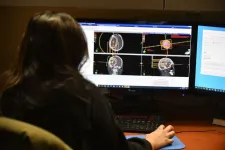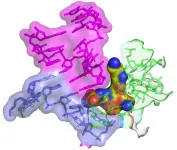(Press-News.org) SEATTLE – (May 16, 2023) – Patients with cancer whose immune systems are being supported or rebuilt by bone marrow transplantation should begin receiving vaccines for protection against SARS-CoV-2 three months post-transplant, according to a large, prospective, observational study led collaboratively by the Center for International Blood and Marrow Transplant Research, the Blood & Marrow Transplant Clinical Trials Network and Fred Hutchinson Cancer Center. The research, involving 22 cancer centers and research institutions in the United States and focusing on mRNA-based vaccines, published in The Lancet journal eClinicalMedicine.
“People with cancer, and especially those undergoing bone marrow transplantation as part of their treatment, are highly vulnerable to infection. Initial studies showed that up to 30% of these patients who became infected with the virus that causes COVID-19 died within four to six weeks,” said Dr. Joshua Hill, a Fred Hutch specialist in treating infectious diseases in people who have cancer and the study’s lead author. Dr. Hill also is an associate professor of medicine at University of Washington School of Medicine.
The study is one of the largest prospective analyses of vaccination for any pathogen within the first year after hematopoietic cell transplant. It evaluated strength of immune response against the virus, comparing results in participants who initiated vaccination earlier than four months versus those who received their first shot four to 12 months after bone marrow transplant.
“We undertook this study to help patients and their doctors determine the best time to begin SARS-CoV-2 vaccination because there was little information on these vaccines in this group of patients,” said Hill. “We found that initiating an mRNA vaccination series between three to four months after bone marrow transplant should be routinely performed as part of a comprehensive infection prevention strategy.”
Although current guidelines in the U.S. call for SARS-CoV-2 vaccination to start three to six months post-transplant, those recommendations were based on limited evidence, such as historical experience with previous vaccines that targeted other pathogens and did not use the mRNA platform. Further, the COVID-19 vaccine efficacy clinical trials did not include participants who had undergone bone marrow transplantation.
Until now, studies of SARS-CoV-2 vaccines in this patient population had been relatively small and primarily focused on patients vaccinated after the three- to 12-month time frame. Some also lacked data on T-cell responses and neutralizing antibodies, which are important measures for accurately assessing protection from severe COVID-19. This study tracked immune responses and safety data in 175 patients who received a first mRNA vaccination within 12 months of bone marrow transplant. All but one patient received mRNA-based vaccines. Of the total, 76 participants were vaccinated within the first four months following bone marrow transplantation; 99 participants were vaccinated between four and 12 months of the procedure.
“There are few studies of mRNA vaccine formulations for SARS-CoV-2 or other pathogens in patients who have undergone bone marrow transplantation,” Hill said. “Our study provides encouraging proof-of-concept for using early vaccination to target this and other pathogens using the mRNA platform.”
Additional study details:
Participants at comprehensive cancer centers were eligible to join the study, which enrolled between April 22, 2021, and Nov. 17, 2021.
Researchers obtained blood before and after each vaccine dose for up to four doses.
The investigators tested for immune response to SARS-CoV-2 spike protein, neutralizing antibodies for several coronavirus variants and SARS-CoV-2-specific T-cell receptors (TCR).
SARS-CoV-2 antibody titers, neutralizing antibody titers and TCR data did not significantly differ at the tested time points following the second vaccination, whether patients started vaccinations before four months or during the period of four to 12 months after bone marrow transplant.
Results did not appear to be impacted by the use of immunosuppressive medications or a diagnosis of graft versus host disease.
The Fred Hutch Bone Marrow Transplant Program, one of the world’s leaders in this treatment, has performed more than 17,000 bone marrow transplants and earned national recognition for outperforming expected one-year survival rates. The program is credited with expanding the clinical use of bone marrow and stem cell transplant more than 40 years ago. Dr. E. Donnall Thomas’ groundbreaking work in transplantation won the Nobel Prize in physiology or medicine in 1990.
Nearly 12,000 bone marrow transplants, called hematopoietic cell transplants, are performed each year in the U.S. BMT can be used to treat blood cancers, like leukemia, lymphoma, multiple myeloma and myelodysplastic syndrome. It can also be used to treat non-cancerous diseases like aplastic anemia, myelofibrosis and immune deficiency disorders. During the procedure, a patient first undergoes chemotherapy and/or radiation to destroy their diseased bone marrow. A donor’s healthy, blood-forming stem cells are then given directly into the patient’s bloodstream.
The study was funded by the National Marrow Donor Program/Be the Match, the Leukemia and Lymphoma Society, the Multiple Myeloma Research Foundation, Novartis, LabCorp, the American Society for Transplantation and Cellular Therapy, Adaptive Biotechnologies and the National Institutes of Health U24 HL138660, P01 CA23766, P30 CA008748 to co-senior author Miguel-Angel Perales of Memorial Sloan Kettering Cancer Center and Weil Cornell Medical College, and P30 CA 015704-47 to Hill. Hill receives research funding from AlloVir and is a consultant for Pfizer, Gilead and Moderna. Additional declarations of potential conflicts of interest and funding acknowledgements are identified in the article.
###
Media Contact:
Claire Hudson
206-919-8300
crhudson@fredhutch.org
About Fred Hutchinson Cancer Center
Fred Hutchinson Cancer Center unites individualized care and advanced research to provide the latest cancer treatment options while accelerating discoveries that prevent, treat and cure cancer and infectious diseases worldwide.
Based in Seattle, Fred Hutch is an independent, nonprofit organization and the only National Cancer Institute-designated cancer center in Washington. We have earned a global reputation for our track record of discoveries in cancer, infectious disease and basic research, including important advances in bone marrow transplantation, immunotherapy, HIV/AIDS prevention and COVID-19 vaccines. Fred Hutch operates eight clinical care sites that provide medical oncology, infusion, radiation, proton therapy and related services and has network affiliations with hospitals in four states. Fred Hutch also serves as UW Medicine’s cancer program.
END
Online workflow systems for off-site radiologists are one reason for health care delays that cost hospitals money and test the patience of patients, according to West Virginia University research.
Bernardo Quiroga, associate professor of supply chain management at the WVU John Chambers College of Business and Economics, and his coauthors analyzed a radiology workflow platform, used by thousands of U.S. hospitals, which allows radiologists working from home to log in, view a pool of tasks such as X-rays or CT and MRI scans that are available for processing, and choose which of those radiological studies to read and report on.
The radiologists’ ...
Contact: Shelby Cefaratti-Bertin, Baylor University Media & Public Relations, 254-327-8012
Follow us on Twitter: @BaylorUMedi
WACO, Texas (May 15, 2023) – For most of U.S. history, tattoos have been associated with sailors and bikers, but not church-going people. As tattoos have become more popular, with nearly one-third of U.S. adults sporting at least one tattoo, religious-themed tattoos have also increased. A recent study examined the behaviors of college students with tattoos, including religious tattoos.
Jerome R. Koch, Ph.D., professor of sociology at Texas Tech University, and Kevin D. Dougherty, Ph.D., professor of sociology at ...
An old antibiotic may provide much-needed protection against multi-drug resistant bacterial infections, according to a new study publishing May 16th in the open access journal PLOS Biology by James Kirby of Harvard Medical School, US, and colleagues. The finding may offer a new way to fight difficult-to-treat and potentially lethal infections.
Nourseothricin is a natural product made by a soil fungus, which contains multiple forms of a complex molecule called streptothricin. Its discovery in the 1940s generated high hopes ...
“The end of modern medicine as we know it.” That’s how the then-director general of the World Health Organization characterized the creeping problem of antimicrobial resistance in 2012. Antimicrobial resistance is the tendency of bacteria, fungus and other disease-causing microbes to evolve strategies to evade the medications humans have discovered and developed to fight them. The evolution of these so-called “super bugs” is an inevitable natural phenomenon, accelerated by misuse of existing drugs and intensified by the lack of new ones in the development ...
Students at the University of Warwick are leading social prescribing research for dementia, highlighting the benefits of this innovative approach during Dementia Action Week.
The ground-breaking dementia café project, led by students from Warwick Medical School, is a shining example of the power of social prescribing in dementia care. By regularly connecting people with dementia to community activities, groups, and services, the project aims to meet practical, social, and emotional needs of people living with dementia while improving their overall health and well-being.
Social prescribing ...
About The Article: This Viewpoint from the Centers for Disease Control and Prevention discusses the prevalence of dengue infection in U.S. territories and opportunities to combat it, such as vaccines and novel vector control methods.
Authors: Alfonso C. Hernandez-Romieu, M.D., M.P.H., of the Centers for Disease Control and Prevention in San Juan, Puerto Rico, is the corresponding author.
To access the embargoed study: Visit our For The Media website at this link https://media.jamanetwork.com/
(doi:10.1001/jama.2023.8567)
Editor’s Note: Please see the article for additional information, including other authors, author contributions and affiliations, conflict ...
Question: In your book you argue the suicidal are oppressed by structural suicidism, a hidden oppression.
Alexandre Baril: “I coined the term suicidism to refer to an oppressive system in which suicidal people experience multiple forms of injustice and violence. Our society is replete with horrific stories of suicidal individuals facing inhumane treatment after expressing their suicidal ideations. The intention is to save their lives at all costs and interventions range from being hospitalized and drugged ...
WASHINGTON, May 16, 2023 – For gummy candies, texture might be even more important than taste. Biting into a hard, stale treat is disappointing, even if it still carries a burst of sweetness. Keeping gummies in good condition depends on their formulation and storage, both of which alter how the molecules in the candies link together.
In Physics of Fluids, by AIP Publishing, researchers from Ozyegin University and Middle East Technical University conducted a series of experiments that explore how changing key parts of the gummy-making process affects the final product, as well as how the candies ...
About The Study: According to two data sources, in 2018, the economic burden of health inequities for racial and ethnic minority populations (American Indian and Alaska Native, Asian, Black, Latino, and Native Hawaiian and Other Pacific Islander populations) was $421 billion or $451 billion and the economic burden of health inequities for adults without a 4-year college degree was $940 billion or $978 billion. The economic burden of health inequities is unacceptably high and warrants investments in policies and interventions to promote health equity for racial and ethnic minorities and adults with less than a 4-year college degree.
Authors: Darrell ...
About The Study: Based on data from the Centers for Disease Control and Prevention, from 1999 through 2020, the Black population in the U.S. experienced more than 1.63 million excess deaths and more than 80 million excess years of life lost when compared with the white population. After a period of progress in reducing disparities, improvements stalled, and differences between the Black population and the white population worsened in 2020.
Authors: Harlan M. Krumholz, M.D., S.M., of the Yale School of Medicine ...



